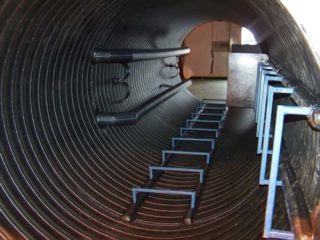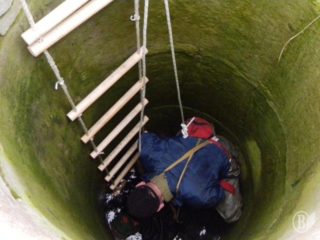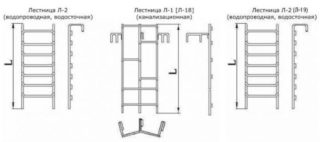Revision installations are equipped so that the distance from the earth's surface to the bottom of the well exceeds a meter. To audit the utility lines and troubleshoot, the foreman must go downstairs. For this he will need a ladder. It must be strong, lightweight and securely attached to the concrete base of the well. These requirements are met by specialized sewer drains and drain ladders. They are designed to facilitate access to pipelines at various levels.
Requirements for sewer ladders

Work in inspection wells is considered harmful and dangerous. Rather stringent requirements are imposed on the equipment.
The qualities that devices for lowering into sewers and gutters must necessarily have:
- Resistant to moisture. In the places where the sewage mains are located, the level of humidity is high. Even with temporary use of ladder structures, water has a destructive effect on their surfaces. The materials from which the stairs are made must be resistant to corrosion.
- Strength. By itself, falling into a well shaft threatens injuries, and if it is also filled with sewage, the danger doubles.
- Reliable fastening on the side of the revision. Ladders are more often hinged, since the bottom of the sewer collectors is hidden from the eyes by sewage, it can turn out to be uneven and slippery. It is much more reliable to strengthen structures with special hooks.
An important requirement is ease of use. Massive, heavy and impractical structures are not suitable for revision. Lightweight, mobile and versatile are needed.
Varieties and design features
The upper parts of the stairs are equipped with reliable hooks that firmly fix them on the well neck. When the master descends into the collector, the structure does not swing.
Workshops for the manufacture of stairs are guided by state standards, but if you need a product that is suitable for certain conditions, specialists are ready to fulfill the order according to the drawings provided. In shallow wells, special brackets are often used, fastened with fixing elements in the ring of the top plate.
In addition to standard ladders, homemade rope structures are also used to descend into observation tanks. Their advantages are mobility and low cost: you can create a product with your own hands. The loops are knitted at a distance of 40 cm, and hooks or other device are attached to the pole to hold the ladder. Such options do not take up space during storage and weigh very little. Realistically adjusting their length. The disadvantage is that if the ropes rot, the user risks health and even life.
Manufacturing material

Standard staircase structures - KL 1 and VL 2 are created from smooth fittings made of high quality stainless steel. Reinforcing bars are practically corrosion-free, resistant to stress and very durable thanks to professional welding.
Fiberglass products are analogs of steel installations. This material is distinguished by such positive qualities:
- resistance to moisture and corrosive liquids;
- dielectric properties, which is important when working near electrical wires;
- strength and lightness.
Manufacturers of fiberglass stairs promise a long service life.
Rope products are made from cotton or synthetic fibers (nylon, polyester). The section of the rope must be more than 10 mm. The treads are made from dense plastic, stainless steel, and even polished shovel handles.
When working in inspection wells, it is not allowed to use equipment made of wood or iron without an anti-corrosion coating. These materials quickly deteriorate when exposed to moisture, which increases the risk of injury and accidents.
Homemade stairs are attractive because they cost almost nothing. But those who do not like to take risks prefer production products with reliable fasteners - durable and withstand a lot of stress.









